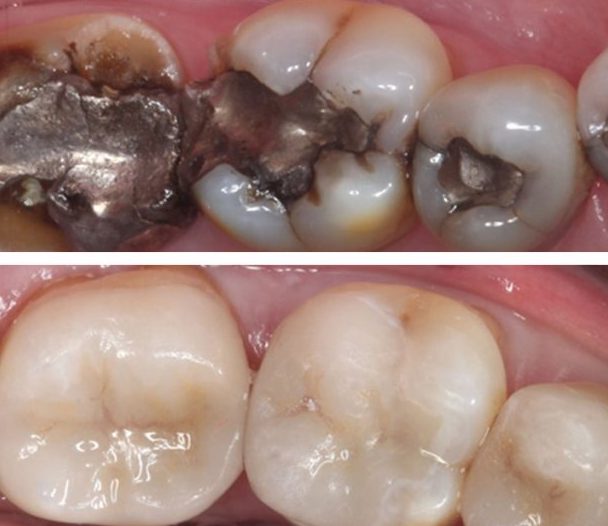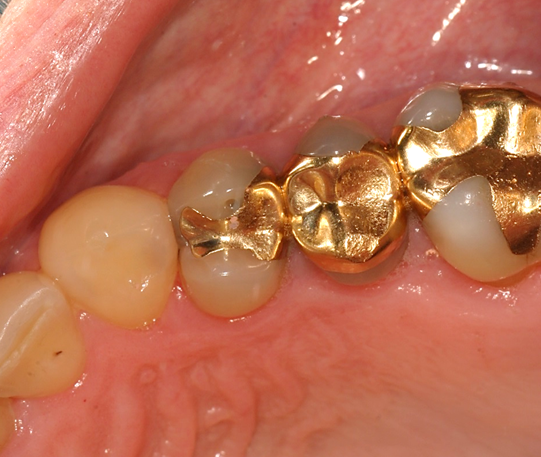Tooth Filling Material
When it comes to tooth filling material, you may think there's only one option, and that your dentist will give you the best filling anyway. But there's more than one possibility when it comes to choosing a tooth filling material. And how long the filling lasts will depend on how well it is done in the first place!
The simplest way to explain the choice between tooth filling materials is to look at the color. This might sound too basic, but it's a valid way of understanding the differences.
The color options are;
- Black (grey / silver)
- White (tooth-colored)
- Gold

Tooth Filling Material
Let's look at these in a bit more detail.
1. Black fillings, which may also be grey, or even silver if your dentist has polished the fillings. These are the fillings we had years ago (and still have). They are metallic, and are called 'amalgam' in dental-speak. Most of us are familiar with the word 'amalgam' in everyday language, meaning a mix or a blend.
In chemistry, an amalgam is a mix of the element Mercury with any other metals. In dentistry, the filling material is known as 'Silver-Tin amalgam', because Silver and Tin are the main components, apart from Mercury. Other elements at low percentages are Zinc and Copper.
The level of Mercury in dental amalgam is usually around 50%, with the other 50% being made up of Silver, Tin Copper and Zinc, with some other trace elements. This means that dental amalgam fillings are half Mercury. This high level of Mercury has caused a lot of debate about the safety of dental amalgam fillings, but to date there is no definitive direct link between amalgam fillings and health.
So, what are the advantages and disadvantages of amalgam as a tooth filling material?
Advantages;
- It's cheap
- It's easy and fast to use
- It lasts a long time
Disadvantages;
- It contains Mercury
- It's not tooth-colored
Tooth Filling Material
2. White (tooth-colored) fillings do not contain Mercury, and may be made from several different materials. The most common is based on bis-GMA resin and dimethacrylate monomers, which dentists refer to as 'composite'. The other 2 possibilities are either a milled dental ceramic (such as Cerec) or a cast disilicate glass, for example eMax.
 Image courtesy Dr. Ray Bertolotti, DDS,Ph.D
Image courtesy Dr. Ray Bertolotti, DDS,Ph.DComposite fillings and milled ceramic fillings (Cerec) can be carried out in one appointment in the dental office. Cast glass fillings are made in a dental laboratory, and need an extra appointment to be fitted. You have a temporary filling while the laboratory is doing its work.

 CAD-CAM milling unit
CAD-CAM milling unit Designing the filling by computer
Designing the filling by computerTooth Filling Material
3. Gold. You don't see this much these days, and it may be seen as being a little 'old-fashioned'. Which is a shame, because gold fillings can last a lifetime if done correctly.
Why has gold gone out of fashion? There are 2 main reasons, plus a 3rd;
- The appearance. Most folk these days want white (tooth colored) fillings. They don't want any metal to show.
- The cost. Although the technique and the laboratory procedures are not time-consuming, the cost of gold has surged recently. At the time of writing (mid-2020), the price of gold on international markets was almost $2000 per ounce.
- Gold fillings are technique sensitive. The dentist needs to make the cavity the correct shape, and take a good impression. And then the lab guy has to make the gold filling that is a very good fit. Finally the dentist has to cement the filling correctly. It's not difficult, but the whole process needs attention to detail.
So, what are the advantages and disadvantages of gold as a tooth filling material?
Advantages;
- Gold is extremely strong. It does not chip or break.
- Gold tends to wear at a similar rate to tooth enamel. This means it doesn't wear down the opposite tooth, like all dental ceramics.
- The filling can last a lifetime.
- It is bio-inert; no Mercury, no plastic resins.
Disadvantages;
- Gold is now expensive
- Some people don't like the yellow color
- It is technique sensitive, and needs attention to detail.
 Image courtesy Dr. Almunk on DT
Image courtesy Dr. Almunk on DTSo, which is the best tooth filling material?
Unfortunately, the answer is 'it depends'. It depends on many factors, such as how prone you are to getting cavities, how old you are, whether you tend to grind your teeth, how well you brush and floss, whether the cavity to be filled is right at the back or only 1/2 way back, and so on. And then there's your budget. How much are you prepared to spend on a filling?
Basically, (and this is just a rule of thumb), if you tend to get new cavities, and you don't brush and floss too well, you may be better off with dental amalgam fillings.
On the other hand, if you rarely get a new cavity these days, and you brush and floss carefully, you can do well with a tooth-colored filling material.
But if you tend to clench and grind your teeth, and regularly break a tooth when chewing (as opposed to getting a new cavity) then gold is the strongest solution.
I hope my guide to tooth filling materials has been helpful. Every person is different, however, and there is no hard-and-fast rule about the best filling material - it depends on your personal circumstances!
Ask your dentist what options he can offer you, and get him to explain the benefits and disadvantages of each - specifically in relation to YOUR teeth. What may be the best option for YOU may be different from someone else!



